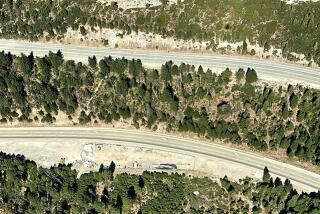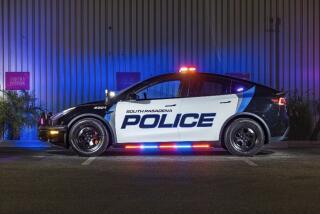The Assignment: Tame the Gas-Guzzling SUV
- Share via
The big Chevrolet Suburban being wheeled around General Motors Corp.’s desert test center in Arizona by a group of college students didn’t look much like a truck of the future.
It seemed to be a stock model, but a peek under the hood quickly put that idea to rest.
Instead of the standard Suburban’s hefty, thirsty V-8, this engine bay was stuffed with a four-cylinder gasoline engine borrowed from a Saturn sedan, along with the maze of electronic gadgetry needed to link it to a pair of electric motors.
The hybrid system gives the big Suburban the performance of a stock model with far less tailpipe emissions and far fewer visits to the gas pump.
The hybrid Suburban is UC Davis’ initial project in the national “FutureTruck” competition, a four-year event that pits university teams from across the nation in a contest to develop ecologically friendly, fuel-efficient versions of the lumbering SUVs that many American motorists seem to love and most environmentalists seem to loathe.
Round One of the contest wraps up with award ceremonies tonight in Washington after a week of final tests and evaluations at GM’s main proving grounds in Milford, Mich.--a year after the initial operating tests at the desert center outside Phoenix.
Expected to be among the victors is California’s only entry, the team from Davis, whose hybrid gas-electric Chevrolet Suburban delivered 27 miles per gallon. And that’s 27 mpg while delivering all of the towing, hill climbing, acceleration, cargo room and range of a stock Suburban with its 15-mpg thirst.
The universities, whose projects ranged from exotic fuel-cell propulsion to hybrid gasoline and diesel power systems mated to electric motors, worked on GM’s biggest consumer vehicle in this round of the contest, which is sponsored by the Department of Energy and several other federal agencies, along with GM, Yahoo Inc. and a number of private automotive technology firms and alternate fuel groups.
Beginning in August, and for the next two years of the program, the universities will be trying to tame Ford Motor Co.’s 2002 Explorer. Ford will replace GM as a sponsor.
The concentration on trucks is important because pickups, sport-utility vehicles and minivans account for nearly half of all new vehicles sold in the U.S. each year and collectively guzzle far more gasoline, and spew more emissions, than passenger cars.
“We’ve seen two hybrid vehicles hit the market,” said Energy Department official Shelley Launey--referring to the five-passenger Toyota Prius and the two-passenger Honda Insight. “We like to think that things like this [FutureTruck project] go a long way to helping with commercial development of these kinds of vehicles,” said Launey, who runs the department’s advanced vehicle competitions.
The competitions also have benefited the auto industry--and the students. At least half the students who have graduated since competing on university teams have taken jobs in the auto industry, Launey said. “They get good jobs and they bring an appreciation for fuel economy and a degree of environmental sensitivity to those jobs.”
GM, which already has hired a number of graduates from the university teams, sees the competition as “a great recruiting opportunity,” says Mark Maher, powertrain systems director for GM’s truck group. “And the rest of the country will eventually benefit from the types of cleaner, more efficient technologies we’re seeing here.”
FutureTruck follows a similar FutureCar competition that ran from 1996 to 1999. UC Davis won that first round with a 67-mpg gas-electric Ford Taurus, but then failed to place in the final round when the team couldn’t get the kinks out of an ambitious experiment with a fuel-saving, continuously variable transmission.
But these are contests in which failure is as honorable as victory.
“The value of this program is that we are previewing the next generation of advanced propulsion technology,” says Bob Larsen, director of the Argonne National Laboratory’s Center for Transportation Research. “These students are encouraged to look at things in an atmosphere of unfettered creativity and the result is combinations of fuels and propulsion equipment you won’t see elsewhere.”
In the quest for improved mileage, the team from the University of Wisconsin went so far as to throw away their Suburban’s steel frame and replace it with a custom-built aluminum frame that shaved 200 pounds from the vehicle’s weight.
Sometimes, Larsen says, experiments in the competition, even failures, help spur important development.
Indeed, UC Davis now has an ongoing project on a hybrid gas-electric power system with a continually variable transmission--which saves fuel by keeping the power train operating at maximum efficiency at all times and eliminating the energy wasted as mechanical gears are shifted.
That FutureCar experience and the results of the truck program’s desert testing last summer “taught us that preparation is everything and that the entire project needs to be well-tested by the time you show up here” at the finals, UC Davis staff researcher Michael Duvall said in a telephone interview from Milford.
Duvall, one of two advisors to the university’s 35-member student team, says that since the desert tests, the students “completely redesigned the control system to make it more reliable and more modular so it is easier to [reconfigure], and designed a new exhaust system treatment for better emissions. We think it can now meet the strictest [emissions] standards in California.”
A number of other teams have switched engines, electric motors and batteries or have made other significant modifications to their entries since the desert testing in attempts to shed weight or gain power and reliability.
The UC Davis team is unusual among the FutureTruck contestants in that it is following a double directive in the competition: to develop a vehicle that could be marketable as a smog-fighter in California as well as to compete for the high-gas-mileage and low-emissions crowns that are the national contest’s goal.
Among other improvements to the stock design, the UC Davis team developed a unique pair of retractable carbon-fiber body panels that extend from the rear of the Suburban at highway speeds to cut down on the air turbulence that slows a vehicle. The result is a 15% reduction in fuel-wasting aerodynamic drag, Duvall says.
And the UC Davis Suburban is a “plug-in hybrid.” While capable of using its gasoline engine and regenerative braking system to provide the power for its electric motors, it also carries storage batteries that can be recharged overnight.
The recharging helps boost fuel economy because there is no parasitic drain on the engine if it doesn’t have to generate electrical power. And Duvall says plugging into the commercial electricity grid isn’t a problem even in California’s tight and costly energy situation. The recharging is done at night when there is a surplus of energy that power companies sell to electric vehicle users at low prices.
The hybrid Suburban can travel about 400 miles on 12 gallons of gas.
For most weekday use, Duvall says, the internal combustion engine would never fire up. The storage batteries hold enough juice to power the electric drive motors for 60 miles of driving--more than most Southern California motorists log on a normal workday.
Because only the electric motors work at low speeds, most off-roading, traffic-jam creeping and parking-lot crawling in this Suburban would be zero-emissions driving.
*
FutureTruck 2001 award ceremonies will be broadcast live on the Internet today from 5 to 7:30 p.m. PDT, at https://www.future truck.gm.com.






